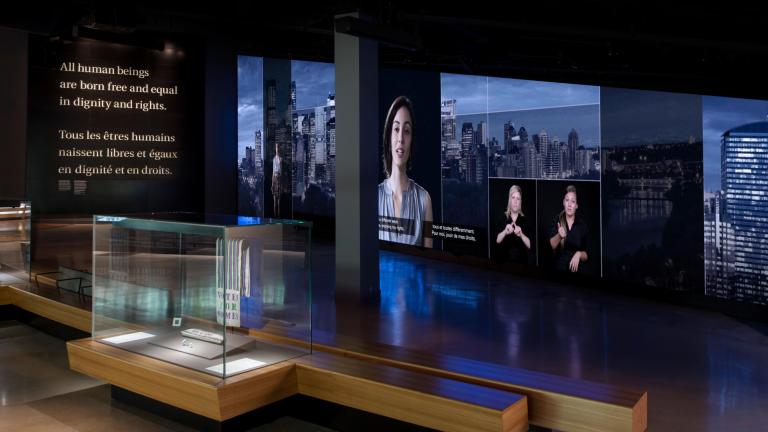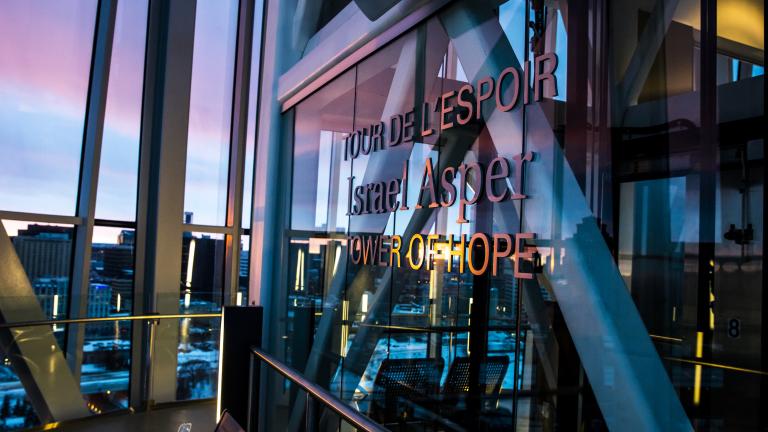Our History
One person's dream, built by a community.
The Museum is the realization of a dream of the late philanthropist Israel Asper, OC, OM, QC, LLD. As a proud and grateful Canadian, Asper spent his lifetime supporting Canadian youth and education projects.

Photo: CMHR, Ian McCausland
In 2000, Israel Asper began to imagine a world‐class human rights centre for Canada. A few short years later, in April 2003, plans for the Canadian Museum for Human Rights were announced by Asper and his supporters. Winnipeg, situated near the longitudinal centre of Canada and the heart of the continent, would play home to the new Museum.
The location at The Forks, where the Red and Assiniboine Rivers meet, also serves a deeper significance. For thousands of years, Indigenous people followed its waterways for peacemaking, dialogue and trade. Today this ancestral land stands as a National Historic Site and the home to the Museum.
Six months after the announcement of the Museum, Asper passed away. But his family and the Friends of the Canadian Museum for Human Rights carried on his mission to establish an iconic site where human rights education and discussion could take place.

From foundation to finish
2003: The plan
Asper and supporters announce their plans to erect the Museum at The Forks.
2003: Architecture
Friends of the Canadian Museum for Human Rights launch one of Canada’s largest‐ever juried architectural competitions, with entries from 63 firms across 21 countries. The competition is won by distinguished architect Antoine Predock.
2008: Our partners
The governments of Canada, Manitoba and Winnipeg join with The Forks Renewal Corporation, the Friends of the Canadian Museum for Human Rights, and individual donors to begin the $351‐million project.
2008: Legislation
On March 13, 2008, the Government of Canada passes Bill C‑42 into law. The bill changes the Museums Act to include the first new national museum in more than 40 years, and the first ever to be built outside of the national capital region.
2008: Excavation
Before the Museum construction begins at The Forks, archeologists, in consultation with respected Elders, conduct an extensive dig and recover more than 400,000 artifacts in the ancestral lands.
2008: Exhibit designers
One of the world’s foremost museum design firms, Ralph Appelbaum Associates, joins the Museum’s research team to create cutting‐edge experiences for visitors.
2008–2012: Construction
On December 19, 2008, a ground‐breaking ceremony is held at The Forks, followed by the beginning of construction in April 2009. In September 2012, the last of 1,669 custom‐cut pieces of glass is installed and work on the base building is completed a few months later.
2009–2010: Consultation
The Museum asks Canadians for their input. People respond that they want the Museum to talk about human rights victories in Canada and the world, today’s ongoing discussions about human rights, and events that demonstrate Canada’s commitment to human rights, as well as its failures.
2010: The Royal blessing
On July 3, 2010, the Museum cornerstone is unveiled by Her Majesty Queen Elizabeth II. She had personally selected a stone from Runnymede, the English meadow where the Magna Carta, a landmark human rights charter, was sealed in 1215. This stone, inscribed with a message from the Queen, is encased in Manitoba Tyndall stone.
2014: Our grand opening
The Museum opens to the public on September 20, 2014.
Our mandate
Established by the Museums Act, we work to enhance understanding of human rights through reflection and dialogue.
The building
Learn about the acclaimed design of the Museum, as it guides you on a journey from darkness to light.

